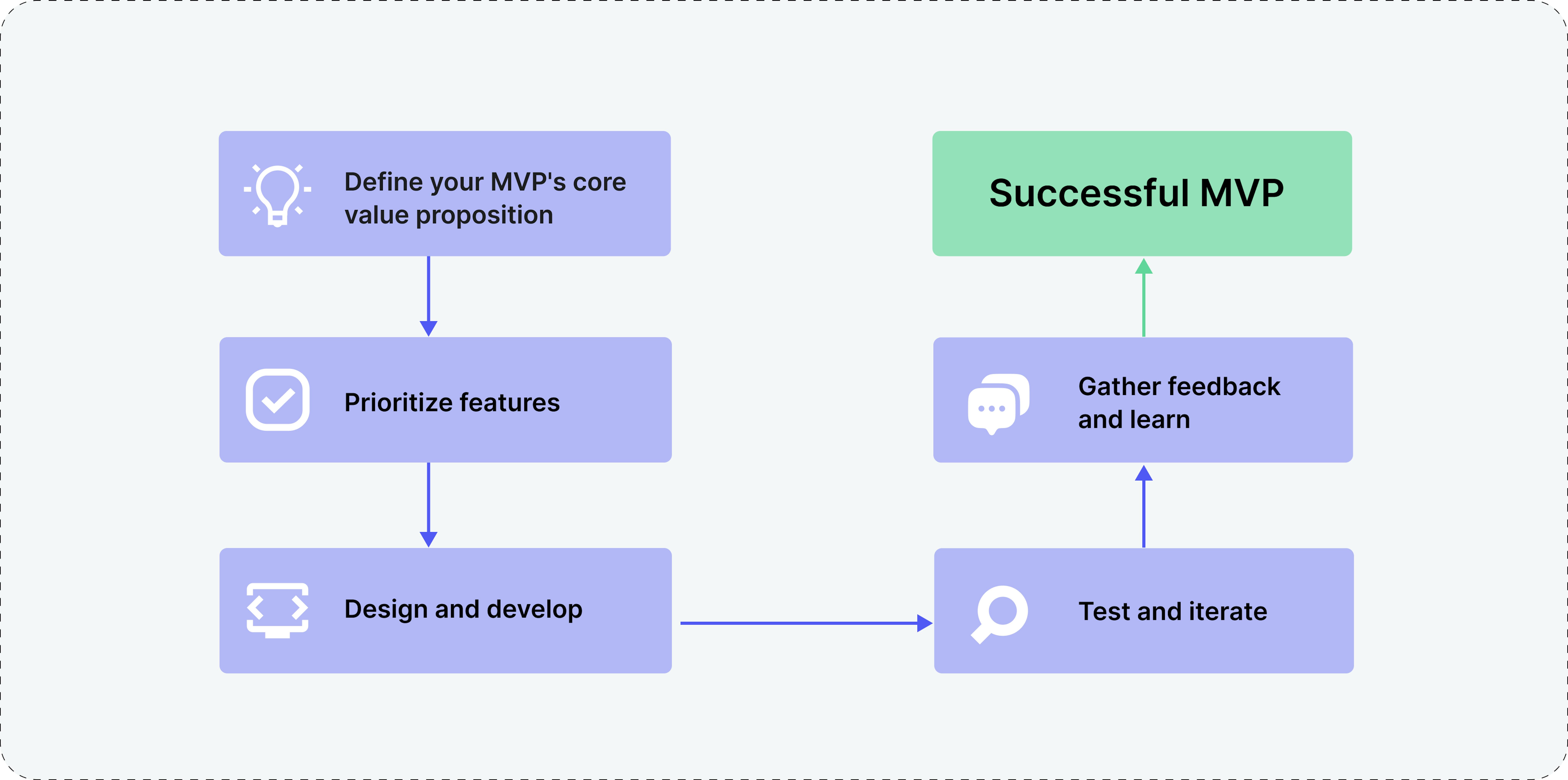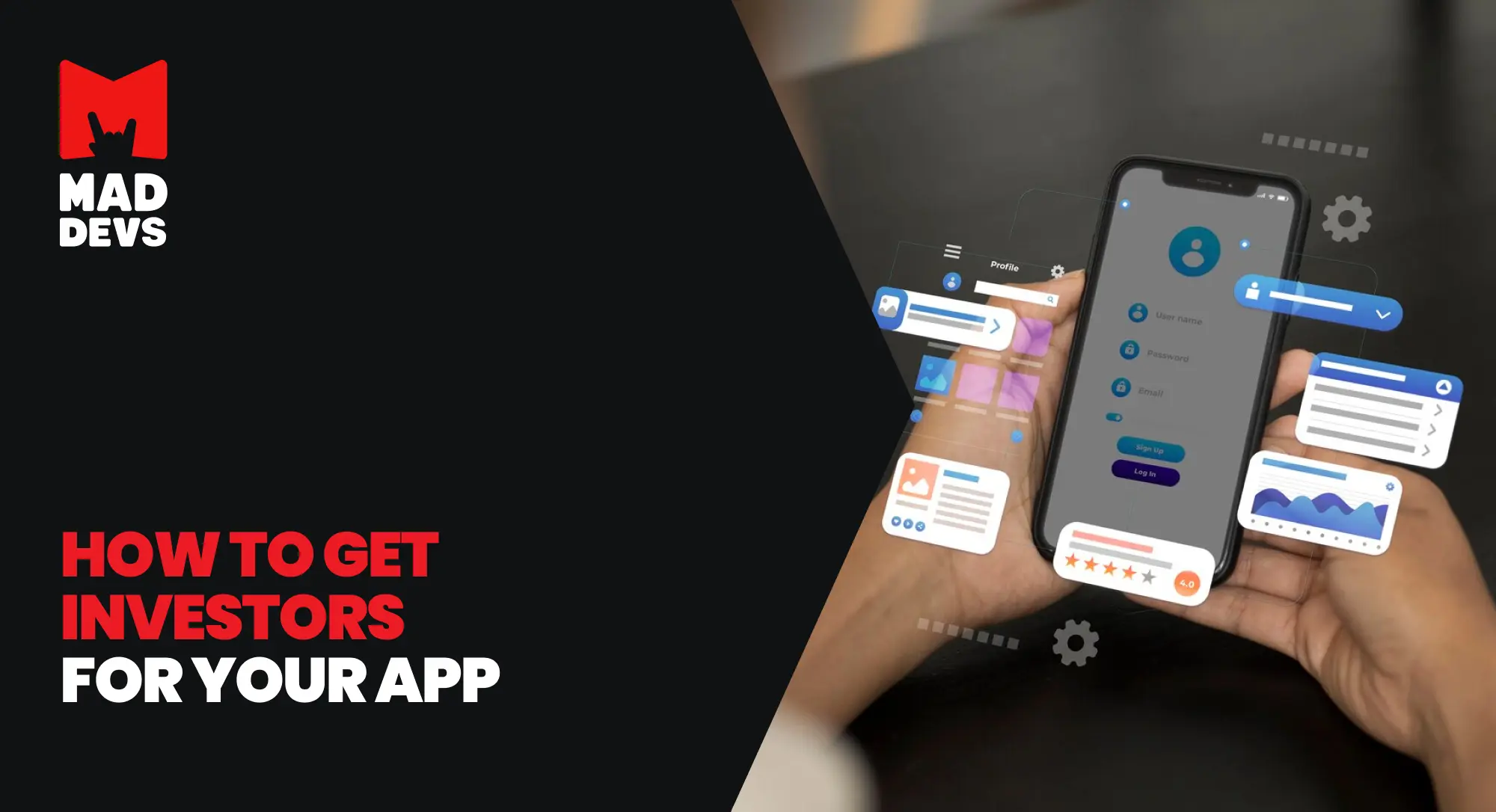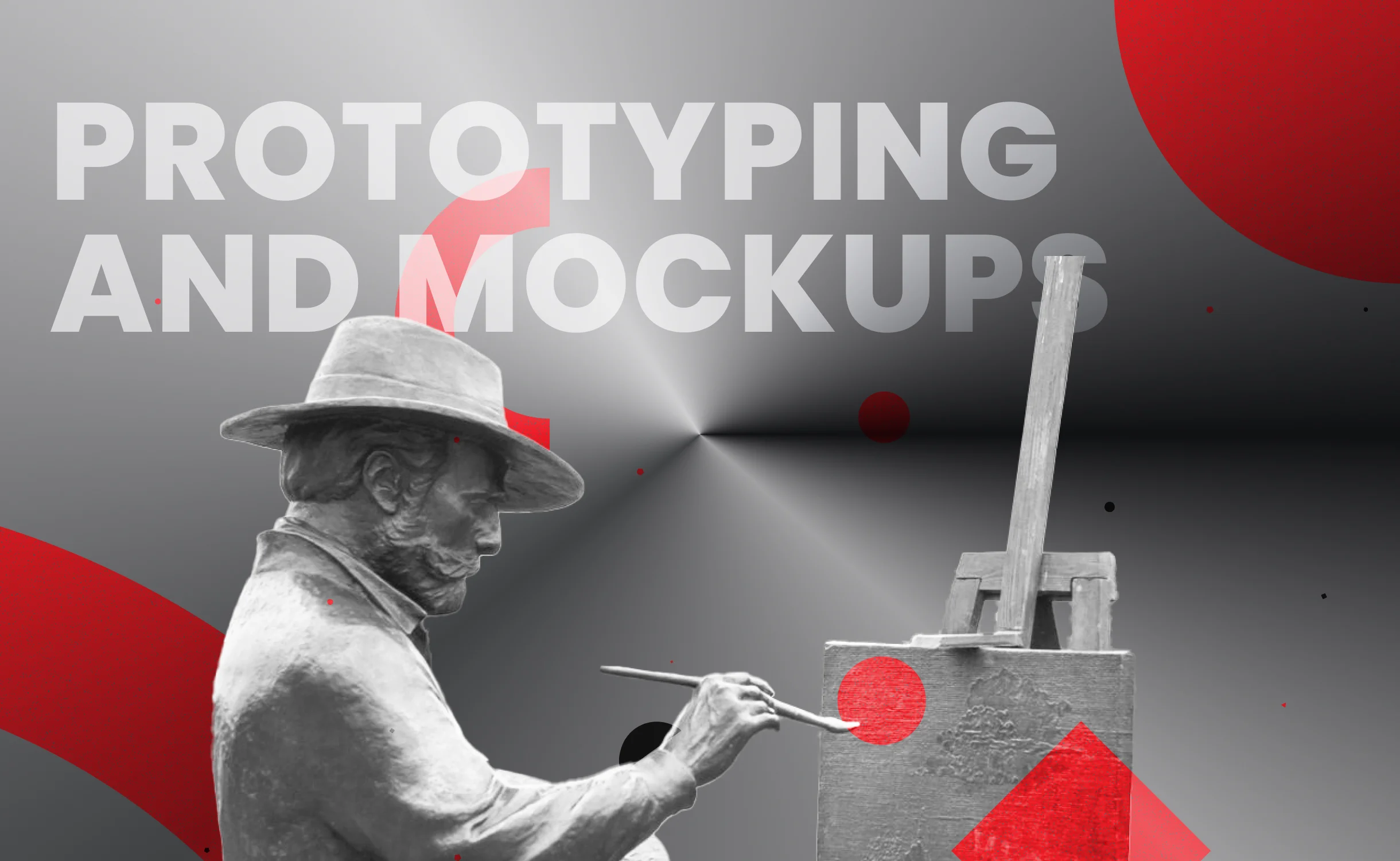Are you a tech entrepreneur looking to launch your next big idea? According to Forbes Advisor, one of the top reasons startups fail—accounting for over 35% of cases—is a lack of market need for their product or service.
Understanding the concept of a minimum viable product (MVP) is essential. By focusing on core features, an MVP approach not only reduces development costs and time to market but also lowers the risk of creating a product that lacks demand.
Let's delve deeper into the world of MVPs and explore how they can revolutionize your product development process.

Why is an MVP important for startups?
A minimum viable product (MVP) is a version of a product with just enough features to attract early-adopter customers and validate a product idea. It's a bare-bones version of your product that allows you to test your assumptions in the market.
For startups, creating an MVP is a strategic move that offers several significant advantages:
1. Cost-effective development
An MVP allows startups to test their core ideas without overspending, ensuring resources are allocated efficiently as the product evolves.
- By focusing only on essential features, startups can minimize upfront expenses.
- Earnings from early releases can be reinvested to build out additional features, improving the product iteratively.
- Testing the market early helps optimize returns on both investment and risk.
2. Accelerated market entry
An MVP speeds up the product launch process, enabling startups to establish their presence, gather insights, and iterate quickly.
- Concentrating on critical features reduces time to launch.
- Quick market assessment — early entry allows startups to gauge demand and product-market fit.
- A launched MVP demonstrates market potential, making the product more attractive to investors.
3. Real-world validation through user feedback
MVPs deliver vital insights from real users early on, allowing startups to validate product ideas and refine them to fit actual market needs.
- An MVP tests the product's viability in the market, preventing overinvestment in low-demand ideas.
- Early adopters' feedback helps startups fine-tune the product to meet real needs.
- Understanding user preferences guides development in a customer-centric direction.
4. Proactive risk management
An MVP approach reduces development risks, allowing startups to test and refine concepts before scaling.
- Testing MVPs ensures the product aligns with market demand.
- MVPs minimize time and resources spent on untested ideas.
- Early testing of core assumptions identifies potential issues before full-scale launch.
5. Built-in opportunities for iterative enhancement
An MVP supports continuous, iterative development, allowing the product to adapt to changing user needs effectively.
- Continuous feedback enables fast updates and improvements.
- Regular iterations keep the product relevant and valuable to users.
- Early insights help identify which features are most important to users.
6. Testing grounds for monetization strategies
An MVP serves as a platform for experimenting with different pricing models and monetization strategies before a full launch.
- Startups can assess if users are ready to pay for the product.
- Testing in-app purchases, subscriptions, or freemium options reveals the best fit.
- Real-world user data helps refine and maximize monetization approaches.
7. Building investor and stakeholder confidence
A well-received MVP can boost investor confidence and attract support by demonstrating the product's viability and growth potential.
- An MVP serves as evidence of both product feasibility and market demand (Proof of Concept).
- Early user engagement and feedback highlight the product's potential.
- A successful MVP demonstrates a clear path to market, fostering investor confidence.
In essence, an MVP is a safety net for startups. It empowers them to validate ideas efficiently, refine their product based on real feedback, and secure critical support from investors. Beyond just a product launch, an MVP provides a strategic framework for sustainable growth and long-term success.
Types of MVPs
Different types of MVPs, such as Concierge, Wizard of Oz, Landing page, and Piecemeal, cater to various needs based on the product's complexity and validation goals. Let's explores these types and provides a roadmap for selecting the best approach for your project.
1. Concierge MVP
- What it is: A product with a manual process that simulates the product's functionality.
- Why use it: To validate market demand and gather user feedback without significant technical investment.
- Example: Zappos initially fulfilled orders manually before automating the process.
2. Wizard of Oz MVP
- What it is: A product that simulates automated features through manual processes.
- Why use it: To test complex features and user experience without building the full-scale product.
- Example: A dating app might initially match users manually before implementing automated algorithms.
3. Landing page MVP
- What it is: A simple landing page to gauge interest and collect email addresses.
- Why use it: To validate a product idea and build an initial user base.
- Example: Buffer initially used a landing page to generate sign-ups before building their full product.
4. Piecemeal MVP
- What it is: A product built using existing third-party tools and services.
- Why use it: To quickly launch a product without significant development effort.
- Example: Groupon initially used WordPress to post deals before building its own platform.
Choosing the right MVP type
Selecting the right type of MVP requires considering multiple factors tied to your goals, market understanding, and operational capabilities:
1. Define your goals:
- Market validation: Determine if there's a genuine demand for your product.
- User feedback: Gather insights into user preferences and behaviors.
- Test core functionality: Validate the core features of your product.
2. Assess your resources:
- Budget: Consider your budget constraints and the resources required for different MVP types.
- Time: Evaluate the time needed to develop and launch each type of MVP.
- Team skills: Assess your team's capabilities and the technical expertise required.
3. Consider your target audience:
- Early adopters: If your target audience is tech-savvy and open to early-stage products, a more complex MVP might be suitable.
- Mass market: For a broader audience, a simpler MVP with a strong value proposition may be more effective.
Here's a quick recap to help you choose:
Landing page MVP: Great for concept validation and building a preliminary user base. Ideal for simpler ideas with minimal validation needs.
Piecemeal MVP: Perfect for launching with minimal development, using existing tools to create a functional experience. Useful for limited resources but requires some integration.
Wizard of Oz MVP: Best for testing complex interactions without full automation, providing authentic feedback on features like matching, recommendations, or customer service.
Concierge MVP: Suited for high-touch experiences where direct, personalized user feedback is needed. Great for testing complex user journeys with a hands-on approach.
Key steps for developing a successful MVP
MVP development requires a structured approach that balances simplicity with value. An MVP allows you to bring a product to market quickly, gather essential user feedback, and test your core idea with minimal investment. Here's a step-by-step guide to building an effective MVP:

1. Define your MVP's core value proposition:
An MVP is only successful if it effectively addresses a genuine problem and resonates with a targeted audience. Start by defining the core value proposition — the essential purpose and promise of your product.
🔲 Clearly articulate the problem your product solves.
🔲 Define the target audience and determine who will benefit most from your product.
🔲 Set specific goals. This can include metrics like user sign-ups, usage frequency, or feedback quality. Clear goals provide direction and a way to measure the success of the MVP's launch.
2. Prioritize features
Once the problem and audience are clear, identify the minimum set of features that will deliver meaningful value. This prioritization helps avoid an overloaded product and ensures you're focused on validating the primary solution.
🔲 Identify the core features that deliver the most value to your users.
🔲 Resist the temptation to add unnecessary features.
🔲 Use user research and feedback to inform your feature prioritization. This ensures that the MVP addresses actual user demands, which increases the likelihood of early adoption.
3. Design and develop
With a clear plan in place, move on to designing and developing your MVP. This phase transforms the concept into a tangible product, focusing on ease of use and a straightforward user experience.
🔲 Start by mapping the product's user journey through wireframes or low-fidelity prototypes. This helps visualize the layout, navigation, and interactions of the core features.
🔲 Select technologies and frameworks that fit your team's expertise, the project's budget, and scalability needs. Consider factors like development speed, future extensibility, and platform compatibility.
🔲 Build the essential functionalities that deliver value to users.
4. Test and iterate
Testing is a crucial phase where you put the MVP into the hands of real users. The feedback gathered here helps refine the product before a larger launch.
🔲 Engage a sample of your target audience in testing to gather insights into usability, functionality, and overall experience.
🔲 Use feedback and data to make necessary adjustments. This might include refining user interface elements, enhancing navigation, or optimizing performance.
🔲 Deploy your MVP to the market and monitor user behavior. Aim for a controlled release where you can monitor how early users interact with the product, helping you understand initial engagement.
5. Gather feedback and learn
The post-launch stage is about gathering feedback, analyzing data, and refining the product based on insights. This continuous improvement approach helps you transition from an MVP to a more complete product.
🔲 Analyze user metrics to understand how users interact with your product.
🔲 Collect feedback through surveys, interviews, and customer support channels. Qualitative data provides a deeper understanding of user satisfaction and specific pain points that quantitative data may miss.
🔲 Use insights from analytics and user feedback to guide product updates and enhancements. By continuously refining the product, you can address emerging user needs, resolve pain points, and gradually develop the MVP into a more robust, market-ready product.
By following these steps and focusing on the core value proposition, you can build a successful MVP that helps you validate your idea, attract early adopters, and iterate towards a fully-featured product.
For expert guidance on validating ideas, defining core features, and crafting a roadmap for your MVP, consider our Project discovery service—an approach designed to help you identify key goals, reduce risks, and ensure a strong foundation for your MVP's success.
5 common mistakes while building an MVP and how to avoid them
Common mistakes can undermine the success of an MVP and lead to significant setbacks. Here are five critical MVP development errors to avoid:
1. Choosing the wrong problem to solve
The first step in building a successful MVP is validating that the problem is worth solving. Before committing months to development, confirm that there's a real demand for your solution. A few guiding questions to ask:
- Who is this for? Identify a clear target audience rather than trying to appeal to everyone.
- What problem will this product solve? Focus on a specific issue that users genuinely need help with.
- Is the proposed idea a strong solution to that problem? Ensure that your idea can meet user needs more effectively than current alternatives.
- It's essential to identify your audience and make sure the solution aligns with their needs. An MVP's success depends on a well-defined problem and audience.
2. Skipping the prototype phase
Imagine building a car without a blueprint. Moving directly to development without a prototype is risky and can lead to misalignment in functionality and design.
- Prototype as a vision: Prototyping serves as a tangible representation of the idea, bridging the concept to the final product. It allows you to visualize the product's flow, understand user interactions, and iterate on the "how" of your solution.
- A pre-MVP tool: Think of the prototype as a smaller, stripped-down MVP that highlights the intended user experience. This allows stakeholders to see the product vision, spot potential flaws, and adjust before major development investments.
- Prototypes prevent costly redesigns, offering a low-risk way to refine the concept.
3. Targeting the wrong audience
To succeed, validate your MVP by gathering feedback from real, potential users rather than friends, family, or anyone outside your target group.
- Acquire relevant feedback: Engage only with users who reflect your target market. Their feedback will be more relevant, actionable, and unbiased.
- Iterate based on real-world input: Use feedback to improve functionality, address user pain points, and optimize features. The iterative loop of test, learn, and improve allows you to refine your product without straying from your audience's needs.
4. Using a wrong development method
A well-defined development process is crucial. Many companies fail because they dive into development without selecting the proper methodology. Two popular approaches for MVP development are Agile and Waterfall:
- Waterfall (Traditional method) — A sequential approach that suits projects with clear, unchanging requirements. However, it lacks flexibility, making it challenging to incorporate feedback once development starts.
- Agile — This iterative, flexible approach is well-suited for MVPs, allowing teams to make ongoing adjustments based on user feedback. Agile enables faster releases and keeps the MVP adaptable as you gain insights from real users.
For most MVPs, we at Mad Devs choose Agile's approach. From our experience, It is more effective, helping teams deliver faster, adapt to change, and ultimately reduce the risk of product abandonment.
5. Confusing qualitative and quantitative feedback
Gathering both qualitative and quantitative feedback is essential, yet many teams overly rely on one or the other, skewing insights and potentially leading to incorrect decisions.
- Qualitative feedback provides insights into user experience, highlighting usability issues and specific pain points in design and functionality. For example, feedback about navigation flow can reveal UX elements that need refinement.
- Quantitative feedback provides metrics-based insights, such as completion rates and time-on-task, to help gauge how effectively users can interact with the product. Quantitative data provides a broad view of performance but lacks context about why users struggle with specific tasks.
Combining qualitative and quantitative insights offers a more accurate picture. Known as "Triangulation feedback," this approach validates findings from both feedback types, increasing confidence in the product's direction. If both feedback methods align, teams can be more assured of the product's readiness for the market.
Balancing these two types of feedback enables informed improvements and reduces the risk of product failure due to insufficient insights.
By avoiding these five common mistakes, you can set your MVP on a path to success. An effective MVP allows you to validate your idea, attract early adopters, and iteratively develop your product into a market-ready solution.
Building a MVP is a pivotal step in the product development journey, and for many companies, outsourcing can streamline this process. Let's delve into different models that are available on the market.
Choosing the right MVP development sourcing model
Developing MVP requires carefully selecting a sourcing model that aligns with your goals, resources, and timeline. Here's a look at three primary models—In-House Development, Partial Outsourcing, and Full Outsourcing—and what each offers.
In-house development: Total control, deep engagement
With in-house development, your team has complete control over every aspect of the project. Key advantages include:
- Deep product understanding — An internal team, fully engaged with the product vision, can make agile, informed decisions.
- Team cohesion — Building a dedicated team fosters strong internal collaboration, leading to efficient workflows and a shared company culture.
- Intellectual property protection — Keeping all rights in-house minimizes IP risks and secures proprietary knowledge.
However, this model demands significant investment in hiring, onboarding, and infrastructure. Scaling quickly to meet shifting project needs can also pose challenges, particularly for smaller organizations with limited resources.
Partial outsourcing: Flexibility and cost efficiency
For businesses seeking a balanced approach, partial outsourcing allows internal teams to focus on core competencies while delegating specific tasks to external partners. Typical outsourced areas may include:
- UI/UX design
- Backend development
- Quality assurance
- Cloud infrastructure setup
Partial outsourcing can optimize costs and accelerate timelines. However, successful execution relies on effective coordination between in-house and outsourced teams to avoid communication breakdowns and maintain cohesive development standards.
Full outsourcing: The turnkey solution
Full outsourcing entrusts the entire development process to an external vendor, ideal for startups with limited resources or tight deadlines. Success with full outsourcing depends on:
- Vendor selection — Choose a vendor with relevant experience, a solid portfolio, and strong communication skills.
- Clear communication — Establish transparent channels and set expectations from the start to ensure alignment.
- Project oversight — Apply rigorous project management practices to track progress and maintain quality.
- Intellectual property protections — Secure IP rights with comprehensive contracts that outline data ownership and confidentiality.
Outstaffing: scalable expertise on-demand
Outstaffing is an ideal model for MVP development when you need access to skilled professionals without the commitment of in-house hiring. This model allows you to augment your existing team with dedicated remote specialists while maintaining direct control over project management.
- Enhanced scalability — Outstaffing enables quick scaling up or down as project demands change.
- Expert access — It gives you access to high-level talent with specialized skills, such as frontend, backend, or mobile development, without the long-term costs of permanent hires.
- Cost and time efficiency — Outstaffing allows for rapid scaling, enabling businesses to add skilled professionals without the commitment and cost of full-time hires.
Success with outstaffing relies on integrating remote specialists into your workflow and maintaining strong communication channels to align the team. This model requires active project management to ensure seamless collaboration.
The best sourcing model depends on your budget, timeline, and in-house expertise. In-house development is ideal for organizations prioritizing control and IP security. Partial outsourcing offers flexibility and cost savings, while full outsourcing provides a comprehensive solution with minimal overhead. Each model has unique benefits, so assess these factors to determine the path that aligns with your development goals.
For further guidance on finding the right sourcing model for your MVP, consider reaching out to Mad Devs for a free consultation. Our experts can help you develop a roadmap that aligns with your resources and vision.
What factors determine MVP pricing?
MVP development cost varies between $15,000 and $150,000, depending on factors like complexity, features, and the team’s expertise and location.
Cost drivers in MVP development vary based on several factors, each influencing the project’s budget. Here's an in-depth look at these cost factors:
- Design requirements: User experience and interface design are often among the first costs. Complex, interactive designs will demand more resources, while simpler layouts keep costs down. Advanced designs require more iteration and designer hours, impacting total costs.
- Technology stack: The choice of programming languages, frameworks, and libraries affects complexity and maintenance needs. While standard stacks are cost-effective, specialized or cutting-edge technologies (e.g., AI, ML) increase development costs.
- Development team type: Your MVP's cost varies with the team you choose. An in-house team offers better alignment with company goals but can be expensive due to salaries, benefits, and infrastructure. Freelance developers may provide flexibility, but quality varies. Outsourced teams, particularly in lower-cost regions, can be cost-efficient, though effective project management is crucial to maintain quality.
- Feature complexity: Basic MVPs with core functionality are cheaper, while those with advanced features (e.g., real-time updates, integrations, or geo-location) increase costs due to additional coding and testing requirements.
- Post-launch maintenance and marketing: After launch, your MVP will need updates, fixes, and possibly feature enhancements. Additionally, marketing efforts to reach target users add to costs. Both are vital for maintaining relevance and encouraging user adoption.
Here's a streamlined summary of potential MVP development costs for a project, with estimates based on an hourly rate of $50 for mid-level specialist:
| EPIC | HOURS (BEST CASE) | HOURS (WORST CASE) | COST ($) |
|---|---|---|---|
| Product discovery | 80 | 160 | $4,000 - $8,000 |
| UX/UI design | 120 | 200 | $6,000 - $10,000 |
| Back-end development | 400 | 600 | $20,000 - $30,000 |
| Front-end development | 300 | 400 | $15,000 - $20,000 |
| Quality assurance/Testing | 150 | 250 | $7500-12500 |
| SEO optimization | 30 | 60 | $1500-3000 |
| Code review | 40 | 60 | $2,000 - $3,000 |
| DevOps/Production delivery | 30 | 50 | $1,500 - $2,500 |
| Project management | 130 | 260 | $6500-13000 |
Additional costs may apply for maintenance and scaling based on project needs. This breakdown offers a comprehensive view of typical MVP costs.
To wrap up
Developing an MVP is about finding the balance between essential functionality and user needs. By focusing on core features and gathering early feedback, you're positioned to refine your product effectively.
Each step, from design to delivery, requires strategic planning, and Mad Devs can support you with tailored solutions. Explore our free consultation service to get started on the path to an MVP that resonates with your audience and goals.












